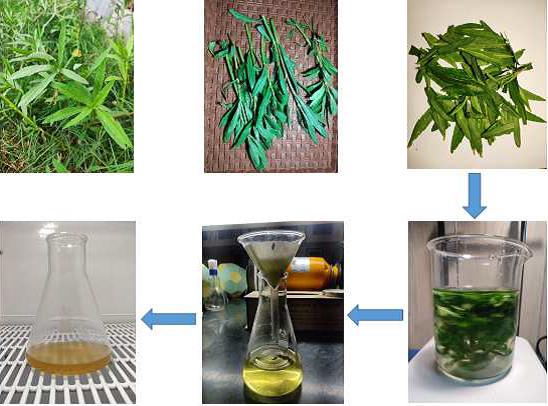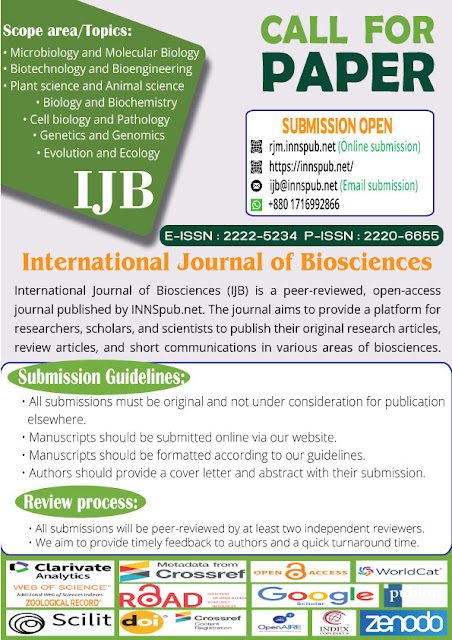Md. Anwarul Kabir
Bhuiya, Md Abdur Rahman, Md Shoeb Md. Asadul Islam , Sajib Madbar, Muniat
Niva, Md. Saiful Islam, and Samia Tabassum, from the different
institute of the Bangladesh. wrote a research article
about' Green Synthesis of Fe3O4 Nanoparticles from Alternanthera
Philoxeroides for Environmental Applications. entitled, Green synthesis
and characterization of magnetite (Fe3O4) nanoparticles using leaf extract of
Alternanthera Philoxeroides for environmental applications. This research
paper published by the International
Journal of Biosciences | IJB. an open access scholarly research
journal on Biology, under the affiliation of the International Network
For Natural Sciences | INNSpub. an open access
multidisciplinary research journal publisher.
Abstract
Iron oxide
nanoparticles, notably magnetite (Fe3O4), have become widely used and a key
topic of research due to their superparamagnetism and distinctive features. As
a result, scientists are diligently looking into new uses for these
nanoparticles. The choice and use of synthesis techniques are important
variables that might affect the size and characteristics of the nanoparticles
(NPs). The use of harmful compounds that are absorbed on the surface of the
nanoparticles has been linked to a number of negative impacts of chemical
production processes. The Green synthesis of nanoparticles has evolved as an
eco-friendly method in response to environmental concerns, giving researchers
the chance to internationally investigate the potential of various herbs for
nanoparticle synthesis. The aqueous extract of Alternanthera Philoxeroides
leaves and the precursors ferric chloride anhydrous (FeCl3 anhydrous) and
ferrous chloride tetrahydrate (FeCl2.4H2O) are used in this study to
demonstrate a green synthesis approach for manufacturing magnetite
nanoparticles. Thermogravimetric analysis (TGA), Fourier transform infrared
spectroscopy (FTIR), vibrating-sample magnetometer (VSM), and UV-visible spectroscopy were used to evaluate the produced FeNPs. The presence of
functional groups including (-OH), (C-H), and (-NH) was detected in the FTIR
findings, showing that organic compounds had been coated on the FeNPs. A
maximum absorption peak was detected in the ultraviolet-visible spectra of the
aqueous media containing iron nanoparticles at about 330 nm. The magnetic
characteristics of the produced FeNPs were verified by VSM testing. Numerous
uses for these nanoparticles exist, such as waste water treatment, energy
production, and others.
Read more: Banana Bunchy Top Disease: First Report in Cagayan Valley, Philippines | InformativeBD
Introduction
Nanoparticles have seen an increase in demand in recent years, due to their use in various fields, including health, catalysis, energy, and drug delivery systems (Nam et al., 2009; Li et al., 2011). The physical, chemical, optical, and electrical properties of these nanomaterials are significantly influenced by the size, shape, and surface morphology of the nanoparticles. Various techniques, including physical vapor deposition, chemical vapor deposition, the solgel method, co-precipitation method, ultrasonic method, electrochemical synthesis, and chemical reduction of metallic ions, are used to create metallic nanoparticles (Horwat et al., 2011; Sobhani et al., 2011; Starowicz et al., 2006). These Syntheses frequently involve toxic, expensive, and unsustainable substances. Due to the simplicity of synthesis, environmental friendliness, and increased stability of nanoparticles, green synthesis approaches based on fungus, microbes, plant and peel extracts are currently being investigated (Balaji et al., 2009; Kumar et al., 2011; Sukirtha et al., 2012).
Because of their high saturation magnetization, Fe3O4 MNPs are simple to magnetically separate in an external magnetic field (Mohamed et al., 2017). Several studies have been done on the synthesis of MNPs using a variety of reducing agents, including hydrazine (Hou et al., 2005). Dimethyl formamide (Jian et al., 2006). Sodium borohydride (Cain et al., 1996). Carbon monoxide (Mondal et al., 2004) and others. The biocompatibility of MNPs is hampered by these highly reactive reducing agents, which also have negative environmental impacts. As a result, there are only a few bio-medical uses for chemically reduced MNPs. MNPs must be strictly biocompatible in order to be used in biomedical applications. Several research using plant extracts to synthesize Fe3O4-NPs have been successful. For instance, Artemisia annua fruit extract (Basavegowda et al., 2014). Perilla frutescens leaf extract (Basavegowda et al., 2014). Tridax procumbens (Senthil et al., 2012). Caricaya papaya extract (Latha et al., 2014). Plantain peel extract (Venkateswarlu et al., 2013). Grape proanthocyanidin seed extract (Narayanan et al., 2012). In the leaf extract, there are a number of polyphenols and acidic compounds available. These Polyphenols from the extract form complexes with metal ions and show both reducing and capping behavior for NPs Senthil et al., 2012. Also, these polyphenolic compounds are biodegradable, nontoxic, and water-soluble at room temperature, which proves that green leaf extract as an effective reducing agent compared to others (Latha et al., 2014). According to the literature analysis, no specific studies have been conducted on the synthesis of Fe3O4-NPs using the alligator weed Alternanthera Philoxeroides, which encourages and pushes us to work on this. We have developed a modified green synthesis method to prepare Fe3O4-NPs using green Alternanthera Philoxeroides extract as a reducing agent, a novel environmentally friendly technique for producing Fe3O4-NPs is suggested in this study.
Reference
Nam J, Won N, Jin H,
Chung H, Kim S. 2009. pH-induced aggregation of gold nanoparticles for
photothermal cancer therapy. Journal of the American Chemical Society 131, 13639–45.
Narayanan KB, Sakthivel
N. 2011. Synthesis and characterization of nano-gold composite using
Cylindrocladium floridanum and its heterogeneous catalysis in the degradation
of 4-nitrophenol. Journal of Hazardous Materials 189, 519–25.
Li J, Chen X, Ai N, Hao
J, Chen Q, Strauf S. 2011. Silver nanoparticle doped TiO2 nanofiber dye
sensitized solar cells. Chem Phys Lett 514, 141–5.
Horwat D, Zakharov DI,
Endrino JL, Soldera F, Anders A, Migot S. 2011. Chemistry, phase
formation, and catalytic activity ofthin palladium-containing oxide films
synthesized by plasma-assisted physical vapor deposition. Surface and Coatings
Technology 205, S171–7.
Dillon AC, Mahan AH,
Deshpande R, Alleman JL, Blackburn JL, Parillia PA. 2006. Hot-wire
chemical vapor synthesis for a variety of nano-materials with novel
applications. Thin Solid Films 501, 216–20.
Sobhani M, Rezaie HR,
Naghizadeh R. 2008. Sol–gel synthesis of aluminum titanate (Al2TiO5)
nano-particles. Journal of Materials Processing Technology 206, 282–5.
Nadagouda MN, Speth TF,
Varma RS. 2011. Microwave-assisted green synthesis of silver
nanostructures. Journal of Hazardous Materials 44, 469–78.
Wani IA, Ganguly A,
Ahmed J, Ahmad T. 2011. Silver nanoparticles: ultrasonic wave assisted
synthesis, optical characterization and surface area studies. Mater Lett 65, 520–2.
Starowicz M, Stypula B,
Banas J. 2006. Electrochemical synthesis of silver nanoparticles.
Electrochem Commun 8, 227–30.
Balaji DS, Basavaraja
S, Deshpandeb R, Mahesh DB, Prabhakara BK, Venkataraman A. 2009.
Extracellular biosynthesis of functionalized silver nanoparticles by strains of
Cladosporium cladosporioides fungus. Colloids Surf B: Biointerfaces 68, 88–92.
Shahverdi AR, Minaeian
S, Shahverdi HR, Jamalifar H, Nohi AA. 2007. NRapid synthesis of silver
nanoparticles using culture supernatants of Enterobacteria: a novel biological
approach. Process Biochem 42, 919–23.
Kumar KP, Paul W,
Sharma CP. 2011. Green synthesis of gold nanoparticles with Zingiber
officinale extract: characterization and blood compatibility. Process Biochem 46, 2007–13.
Dubey SP, Lahtinen M,
Sillanpaa M. 2010. Tansy fruit mediated greener synthesis of silver and
gold nanoparticles. Process Biochem 45, 1065–71.
Sukirtha R, Priyanka
KM, Antony JJ, Kamalakkannan S, Thangam R, Gunasekaran P. 2012. Cytotoxic
effect of Green synthesized silver nanoparticles using Melia azedarach against
in vitro HeLa cell lines and lymphoma mice model. Process Biochem 47, 273–9.
Mohamed Saleh A. 2017.
“Immobilization of horseradish peroxidase on Fe3O4 magnetic
nanoparticles.” Electronic Journal of Biotechnology 27, 84-90.
Hou Yanglong. 2005.
“Inorganic nanocrystal self-assembly via the inclusion interaction of
β-cyclodextrins: toward 3D spherical magnetite.” The Journal of Physical
Chemistry B 109(11), 4845-4852.
Jian Pan. 2006. “Preparation
of polysulfone–Fe3O4 composite ultrafiltration membrane and its behavior in
magnetic field.” Journal of Membrane Science 284, 1-2 9-16.
Cain Jason L. 1996.
“Preparation of α-Fe particles by reduction of ferrous ion in
lecithin/cyclohexane/water association colloids.” Journal of magnetism and
magnetic materials 155(13), 67-69.
Mondal K. 2004.
“Reduction of iron oxide in carbon monoxide atmosphere—reaction controlled
kinetics.” Fuel Processing Technology 86(1), 33-47.
Basavegowda
Nagaraj. 2014. “Green fabrication of ferromagnetic Fe 3 O 4 nanoparticles
and their novel catalytic applications for the synthesis of biologically
interesting benzoxazinone and benzthioxazinone derivatives.” New Journal
of Chemistry 38(11), 5415-5420.
Basavegowda Nagaraj,
Kanchan Mishra, Yong Rok Lee. 2014. “Sonochemically synthesized
ferromagnetic Fe 3 O 4 nanoparticles as a recyclable catalyst for the
preparation of pyrrolo [3, 4-c] quinoline-1, 3-dione derivatives.” RSC
Advances 106(4), 61660-61666.
Senthil M, Ramesh C. 2012.
“BIOGENIC SYNTHESIS OF Fe 3 O 4 NANOPARTICLES USING TRIDAX PROCUMBENS
LEAF EXTRACT AND ITS ANTIBACTERIAL ACTIVITY ON PSEUDOMONAS
AERUGINOSA.” Digest Journal of Nanomaterials & Biostructures
(DJNB) 7(4).
Latha N, Gowri M. 2014.
“Biosynthesis and characterisation of Fe3O4 nanoparticles using Caricaya papaya
leaves extract.” International Journal of Scientific and Research 3(11), 1551-1556.
Venkateswarlu Sada. 2013.
“Biogenic synthesis of Fe3O4 magnetic nanoparticles using plantain peel
extract.” Materials Letters 100, 241-244.
Narayanan Sreeja. 2012.
“Biocompatible magnetite/gold nanohybrid contrast agents via green chemistry
for MRI and CT bioimaging.” ACS applied materials & interfaces 4(1), 251-260.
Venkateswarlu
Sada. 2014. “Bio-inspired green synthesis of Fe3O4 spherical magnetic
nanoparticles using Syzygium cumini seed extract.” Physica B: Condensed
Matter 449, 67-71.
Pham Xuan Nui. 2016.
“Synthesis and characterization of chitosan-coated magnetite nanoparticles and
their application in curcumin drug delivery.” Advances in Natural
Sciences: Nanoscience and Nanotechnology 7(4), 045010.
Ramesh AV. 2018.
“Facile green synthesis of Fe3O4 nanoparticles using aqueous leaf extract of
Zanthoxylum armatum DC. for efficient adsorption of methylene blue.” Journal of
Asian Ceramic Societies 6(2), 145-155.
Ahmad Sharif. 2009.
“Soft template synthesis of super paramagnetic Fe 3 O 4 nanoparticles a novel
technique.” Journal of Inorganic and Organometallic Polymers and
Materials 19, 355-360.
Bishnoi, Shahana, Aarti
Kumar, Raja Selvaraj. 2018.”Facile synthesis of magnetic iron oxide
nanoparticles using inedible Cynometra ramiflora fruit extract waste and their
photocatalytic degradation of methylene blue dye.” Materials Research
Bulletin 97, 121-127.
Yew Yen Pin. 2016.
“Green synthesis of magnetite (Fe 3 O 4) nanoparticles using seaweed
(Kappaphycus alvarezii) extract.” Nanoscale research letters 11, 1-7.
Sirdeshpande, Karthikey
Devadatta, 2018. “Structural characterization of mesoporous magnetite
nanoparticles synthesized using the leaf extract of Calliandra haematocephala
and their photocatalytic degradation of malachite green dye.” Applied
Nanoscience 8, 675-683.
Ahmad Sharif. 2009.
“Soft template synthesis of super paramagnetic Fe 3 O 4 nanoparticles a novel
technique.” Journal of Inorganic and Organometallic Polymers and
Materials 19, 355-360.
Das Chanchal. 2020.
“Green synthesis, characterization and application of natural product coated
magnetite nanoparticles for wastewater treatment.” Nanomaterials 10(8), 1615.
Pham Xuan Nui. 2016.
“Synthesis and characterization of chitosan-coated magnetite nanoparticles and
their application in curcumin drug delivery.” Advances in Natural
Sciences: Nanoscience and Nanotechnology 7(4), 045010.
Akbarizadeh, Majid
Reza. 2022. “Cytotoxic activity and Magnetic Behavior of green synthesized
iron oxide nanoparticles on brain glioblastoma cells.” Nanomedicine
Research Journal 7(1), 99-106.
Rami JM. 2021.
“Thermogravimetric analysis (TGA) of some synthesized metal oxide
nanoparticles.” Materials Today: Proceedings 43, 655-659.
Bhuiyan Md Shakhawat
Hossen. 2020. “Green synthesis of iron oxide nanoparticle using Carica
papaya leaf extract: application for photocatalytic degradation of remazol
yellow RR dye and antibacterial activity.” Heliyon 6(8).
Rajendrachari,
Shashanka. 2020. “A fast and robust approach for the green synthesis of
spherical Magnetite (Fe3O4) nanoparticles by Tilia Tomentosa (Ihlamur) leaves
and its antibacterial studies.
Jalil WBF. 2017.
“Low toxicity superparamagnetic magnetite nanoparticles: One-pot facile green
synthesis for biological applications.” Materials Science and Engineering:
C 78, 457-466.












%20in%20full.JPG)


0 comments:
Post a Comment